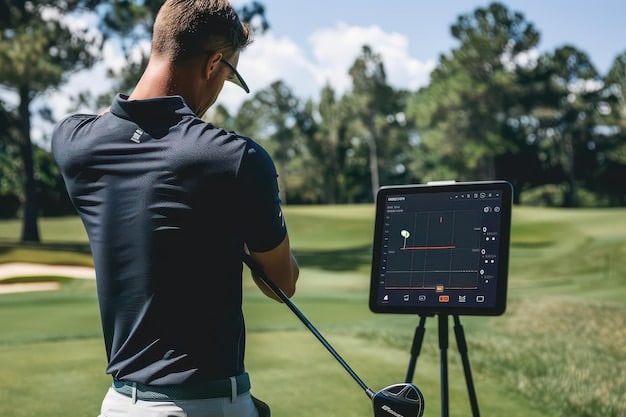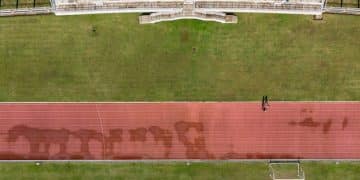Improve Golf Swing 20% with Video Analysis

Achieving a 20% improvement in your golf swing is attainable through a structured approach featuring advanced video analysis, enabling precise identification of flaws, tailored corrective drills, and objective measurement of progress for significant performance enhancement.
Unlocking your full potential on the golf course often hinges on refining the very core of your game: the swing. This comprehensive guide, focusing on Practical Solutions: A Step-by-Step Guide to Improving Your Golf Swing by 20% Using Advanced Video Analysis Techniques, delves into how modern technology, specifically video analysis, can be leveraged to achieve significant, measurable improvements in your golf swing.
Understanding the Science of a Golf Swing
The golf swing is a complex, athletic motion, a delicate dance between power, precision, and consistency. It’s not merely about hitting a ball; it’s a meticulously choreographed sequence of movements involving the entire kinetic chain. Understanding the fundamental mechanics and biomechanics of an effective swing is the first critical step toward improvement. Without this foundational knowledge, identifying specific areas for enhancement becomes a guessing game rather than a targeted effort.
Every professional golfer adheres to certain universal principles, even if their individual styles vary. These include proper grip, posture, alignment, and a consistent swing plane. Deviations in any of these areas can lead to significant inconsistencies and a loss of power or accuracy. The inherent challenge lies in the speed of the swing—it’s too fast for the naked eye to detect subtle flaws directly.
The Core Elements of a Consistent Swing
A golf swing is often broken down into distinct phases, each crucial for the overall outcome. Analyzing these segments individually helps isolate issues before reintegrating them into a cohesive movement. The primary components that contribute to a consistent and powerful swing include:
- Grip: The connection point between player and club; proper grip ensures control and power transfer.
- Setup/Posture: Establishes the foundation for balance and athletic movement throughout the swing.
- Backswing: The takeaway and coil, where power is loaded and the club is positioned for the downswing.
- Transition: The crucial shift from backswing to downswing, initiating the uncoiling of the body.
- Downswing: The release of stored energy, accelerating the club towards impact.
- Impact: The moment of truth, where the club face meets the ball, dictating direction and trajectory.
- Follow-through: The natural deceleration, allowing for full body rotation and balance.
Each of these elements must operate in harmony. A weakness or inefficiency in one area often cascades, negatively impacting subsequent phases. For instance, an improper setup can lead to an off-plane backswing, which then forces compensatory movements during the downswing, ultimately resulting in inconsistent impact. The goal, therefore, is not just to fix individual flaws, but to understand how they interconnect within the entire sequence.
Setting Realistic Goals for Swing Improvement
Before diving into the mechanics of video analysis, it’s imperative to establish clear and measurable objectives. A 20% improvement might sound ambitious, but with the right tools and a systematic approach, it is entirely attainable. This isn’t about magical fixes, but rather consistent, incremental gains. Defining what “improvement” means for your specific swing is crucial.
For some, a 20% improvement might translate to gaining 20 yards on their drives, consistently hitting more fairways, or reducing their handicap by a certain margin. For others, it could mean eliminating a significant slice or hook, or achieving a more repeatable ball flight. Setting these specific, quantifiable goals provides a roadmap and benchmarks against which progress can be measured. Without them, the entire process lacks direction and motivation.
It’s also important to manage expectations. Swing changes take time and dedicated practice. There will be frustrating days where it feels like you’re taking two steps back for every one forward. Patience and persistence are key. The 20% target serves as a powerful motivator, but the journey itself is often more valuable than the destination, as it builds discipline and a deeper understanding of your own game. Incremental progress, carefully tracked, is what ultimately leads to substantial gains.

The Power of Advanced Video Analysis
Video analysis has revolutionized golf instruction, moving it from subjective observation to objective data. Gone are the days when a coach simply told you what they thought they saw. With high-speed cameras and sophisticated software, every nuanced movement of the swing can be captured, slowed down, and scrutinized in detail. This technological leap allows for an unprecedented level of precision in diagnosing swing faults.
Modern golf analysis software goes beyond simple slow-motion playback. It allows instructors and players to draw lines indicating swing planes, head movement, hip rotation, and more. It can compare your swing side-by-side with professional models, highlighting discrepancies. Some systems even provide quantitative data, such as clubhead speed, ball speed, launch angle, and spin rate, offering a holistic view of cause and effect.
The beauty of video analysis lies in its ability to provide instant, undeniable feedback. It removes the guesswork. When a golfer sees their swing flaws on screen, often for the first time with clarity, the “aha!” moment occurs. This visual reinforcement is incredibly powerful for learning and retention, making the corrective process far more efficient and effective than verbal cues alone.
Choosing the Right Equipment and Software
While professional setups can be expensive, there are accessible options for amateurs. A smartphone with a good camera is often sufficient, especially when paired with free or low-cost golf swing analysis apps. For more advanced users, a dedicated high-speed camera can capture frames per second that reveal even the most minute details of the swing.
- Smartphones/Tablets: Most modern devices offer slow-motion video recording, ideal for basic analysis. Apps like V1 Golf or Hudl Technique provide overlays and comparison features.
- High-Speed Cameras: For granular detail, dedicated cameras (e.g., Casio Exilim series, Phantom series) can capture thousands of frames per second, revealing subtle wrist movements or shaft flex.
- Launch Monitors: Devices like Trackman, Foresight GCQuad, or SkyTrak combine video with data points such as club path, face angle, and smash factor, linking swing mechanics directly to ball flight.
- Analysis Software: Beyond mobile apps, desktop software (e.g., Swing Catalyst, K-Motion) offers advanced biomechanical analysis, force plate integration, and 3D modeling.
The key is to select equipment that aligns with your budget and analytical needs. Even basic video analysis offers significant advantages over traditional methods. The investment, whether in time or equipment, pays dividends in accelerated learning and measurable improvement.
Step-by-Step Video Analysis Process
Effective video analysis is a systematic process, not just about randomly recording swings. To maximize insights, it’s crucial to follow a structured approach from setup to interpretation. This ensures consistent data collection and accurate identification of swing characteristics.
1. Setup and Filming
Proper camera positioning is paramount for capturing a useful swing sequence. Two primary angles are recommended for comprehensive analysis:
- Down-the-Line (DTL): Place the camera directly behind the golfer, aligned with the target line, at hip height. This angle is essential for analyzing swing plane, club path, and body rotation.
- Face-On (FO): Position the camera directly in front of the golfer, perpendicular to the target line, at chest height. This angle reveals weight shift, head movement, wrist angles, and overall body balance.
Ensure ample light and a clear background to avoid distractions. Record several swings, varying club types if necessary, to ensure consistency and capture a representative sample of your typical motion. Recording at a higher frame rate (e.g., 120fps or 240fps on most smartphones) allows for smoother slow-motion playback.
2. Initial Review and Identifying Obvious Flaws
After filming, the first step is a general overview. Watch your swings at normal speed and then in slow motion. Look for major inconsistencies or movements that feel “off.” Common issues often jump out: excessive head movement, premature release of the club, or significant swaying. This initial review helps narrow down the focus for deeper analysis.
3. Detailed Analysis and Comparison
This is where the magic happens. Use your chosen analysis software or app to meticulously examine each segment of your swing. Compare it side-by-side with a model swing (either a professional or a previous, better version of your own). Draw lines to objectively assess:
- Swing Plane: Is the club on plane during the backswing and downswing?
- Head Movement: Is your head staying relatively stable or moving excessively up, down, or sideways?
- Hip Rotation: Are your hips rotating effectively during the backswing and through impact?
- Weight Shift: Is your weight transferring properly from back foot to front foot?
- Wrist Angles: Are you maintaining proper wrist hinge and lag?
Document what you observe. Be specific rather than vague. For instance, instead of “my swing is messy,” note “my lead wrist cups at the top of the backswing,” or “my hips slide rather than rotate during the downswing.” This objective data forms the basis for your corrective efforts.
Implementing Corrective Drills and Practice Plans
Identifying flaws through video analysis is only half the battle; the real work begins with implementing targeted corrective drills. A well-designed practice plan, informed by your video findings, is crucial for translating analytical insights into tangible improvements on the course.
Tailoring Drills to Specific Flaws
For every swing fault identified, there are specific drills designed to correct it. It’s vital to choose drills that directly address your discovered weaknesses. For example:
- If your swing plane is too upright: Practice a closed-stance takeaway or use alignment sticks on the ground to guide your backswing on a flatter path.
- If you’re swaying or losing balance: Perform balanced setup drills, half-swings focusing on a stationary head, or practice with feet together.
- If you lack hip rotation: Use a medicine ball twist drill, or practice turning your hips against a wall or chair to feel the rotational movement.
- If you’re casting the club early (losing lag): Practice “L-to-L” drills, focusing on maintaining the wrist hinge until late in the downswing, or use impact bag drills to feel the compressed impact.
Start with smaller, simpler movements that isolate the problem area. Don’t try to fix everything at once. Focus on one or two key elements at a time until you see consistent improvement.
Structuring Your Practice Sessions
Effective practice isn’t just about hitting hundreds of balls. It’s about purposeful repetition with a clear objective. Integrate your video analysis into your practice routine:
- Warm-up: Begin with dynamic stretches and a few light swings to get the body ready.
- Drill Repetition: Dedicate the majority of your time to performing your targeted corrective drills. Focus on the *feel* of the correct movement, not just the outcome of the shot. Take practice swings without a ball.
- Video Feedback: Periodically record yourself during your drill sessions. Immediately review the footage to see if the drill is helping you achieve the desired change. This instant feedback loop is incredibly powerful.
- Ball Striking Integration: Once you start to feel the correct movement without the ball, gradually introduce hitting balls, but maintain your focus on the swing thought or feeling, not just the result.
- Random Practice: Mix up clubs and targets to simulate on-course conditions, reinforcing the new movement under varied circumstances.
Remember, the goal is to make the correct movement feel natural and automatic. This requires consistent, focused effort over time. Short, frequent practice sessions (3-4 times a week for 30-60 minutes) are often more effective than one long, infrequent session.
Measuring Progress and Refining Your Approach
The journey of swing improvement is iterative. Once you’ve implemented corrective drills, the next crucial step is to objectively measure your progress and refine your approach based on the data. This continuous feedback loop ensures you stay on the right track towards your 20% improvement goal.
Tracking Key Performance Indicators (KPIs)
Beyond simply “feeling better,” you need concrete metrics to confirm improvement. These KPIs can vary based on your initial goals, but typically include:
- Swing Speed/Club Head Speed: If power is a goal, track this with a launch monitor or swing speed radar.
- Ball Speed/Carry Distance: Directly related to power and solid contact.
- Launch Angle/Spin Rate: Optimized for distance and accuracy (especially with a driver).
- Dispersion (Fairway/Green Hit Percentage): Are you hitting more targets consistently?
- Handicap Reduction: The ultimate measure of overall game improvement.
- Video Progress: Compare new swing videos with old ones. Are the previously identified flaws diminishing? Are new, better patterns emerging? Draw new lines to show the change.
Keep a practice journal or use a golf tracking app to record your sessions, what you worked on, and the results. This data-driven approach helps you identify what’s working and what’s not, allowing for informed adjustments to your practice plan.
Troubleshooting and Adjusting Your Plan
It’s rare for a swing change to be a smooth, linear progression. You’ll likely encounter plateaus, regressions, or new issues emerging as old ones are corrected. This is where the iterative process comes into play. If you’re not seeing the desired improvement, pause, re-analyze, and adjust:
- Re-video: Film new swings to see if the core issue persists or if a new compensation has developed.
- Consult an Expert: If self-analysis becomes challenging, consider a session with a certified golf instructor. They can offer an objective perspective and utilize more advanced tools.
- Simplify: Sometimes trying to fix too much at once leads to overload. Revert to focusing on just one key element.
- Vary Practice: If you’re stuck in a rut, try practicing on different surfaces, with different clubs, or at varying speeds to challenge your new movement patterns.
The commitment to continuous learning and adaptation is critical for long-term improvement. Your swing is a dynamic entity, and so too should be your approach to its refinement.
Integrating Video Analysis with On-Course Performance
The ultimate test of any swing improvement lies not on the practice range, but on the golf course. It’s one thing to execute a mechanically sound swing in a controlled environment; it’s another to replicate it under pressure, with varying lies, and shifting conditions. Bridging the gap between practice and play is a crucial final step.
Transitioning Drills to the Course
Don’t expect immediate perfection on the course. The muscle memory developed through drills takes time to embed and feel natural. Start by taking your “feeling” or swing thought from the range onto the course, but don’t overthink it. Focus on one or two key sensations rather than a laundry list of swing mechanics. For example, if you’ve been working on hip rotation, just focus on feeling that complete turn during your actual swing. The goal is to trust your practice, not to actively micro-manage every movement.
In the initial phases of implementing new mechanics on the course, results might actually worsen temporarily. This is a common and often necessary part of the process, as the old habits fight against the new ones. Be patient and persistent. Focus on the process, not just the immediate outcome of the shot. Consciously making the effort to implement your new swing thoughts, even if it leads to a few wayward shots, is part of the learning curve.
Post-Round Analysis and Future Planning
After your round, resist the urge to immediately dwell on frustrations. Instead, engage in a reflective process. What shots felt good? Where did your previous flaws reappear? What conditions contributed to certain outcomes?
Consider:
- Performance Metrics: Review your scorecard. Where did you lose strokes? Was it due to poor driving, inaccurate iron play, or short game issues?
- Anecdotal Evidence: Reflect on specific shots. Did you miss left or right? Did you chunk or thin any shots? Connect these outcomes back to potential swing characteristics.
- Video Review (if possible): Some golfers even record a few swings during a casual practice round to see how their mechanics hold up under real-time play.
Use this post-round analysis to refine your next practice session. If you consistently chunked short iron shots, perhaps your weight transfer isn’t complete. If you’re slicing your driver under pressure, maybe your club face is still open at impact. This continuous feedback loop—practice, play, analyze, refine—is the cornerstone of sustained improvement and will undoubtedly help you achieve and even surpass your 20% swing enhancement goal, leading to more enjoyable and successful rounds of golf.
| Key Aspect | Brief Description |
|---|---|
| 🎥 Video Analysis | Utilizes high-speed cameras and software to objectively identify swing flaws for precise correction. |
| 🛠️ Targeted Drills | Specific exercises designed to correct individual swing faults identified through detailed analysis. |
| 📈 Measurable Goals | Setting quantifiable objectives (e.g., yardage, handicap) to track and validate swing improvement. |
| 🔄 Iterative Process | Continuous cycle of analysis, practice, measurement, and refinement for ongoing swing mastery. |
Frequently Asked Questions
▼
Achieving a 20% improvement is a significant goal that typically takes consistent dedication over several months, rather than weeks. The speed of improvement depends on your initial skill level, commitment to practice, and the effectiveness of your corrective drills. While some minor flaws might show quick fixes, fundamental changes require time for new muscle memory to develop and stabilize under varying conditions.
▼
Video analysis excels at revealing subtle, yet impactful, swing flaws often missed by the naked eye. Common issues include improper weight transfer (swaying), an off-plane backswing or downswing, loss of posture (standing up), premature wrist unhinging (casting), and incorrect hip rotation. It can also highlight issues with clubface control at impact, leading to slices or hooks.
▼
While professional instructors use high-speed cameras and advanced software, you don’t necessarily need expensive equipment. A modern smartphone or tablet with its slow-motion video capability is often sufficient, especially when paired with free or affordable golf analysis apps. For more detailed data, a personal launch monitor can be a valuable addition, but a simple camera setup is a great starting point for foundational analysis.
▼
While self-video analysis is incredibly powerful for identifying issues and monitoring progress, a certified golf instructor provides invaluable objective insight. They can pinpoint nuanced flaws you might miss, offer tailored drills, and ensure you’re practicing effectively. Combining self-analysis with occasional professional guidance offers the fastest and most efficient path to significant and lasting swing improvement.
▼
The “20% improvement” is a measurable target, often translating to a range of gains depending on your starting point and specific goals. It could mean increasing driving distance by 20 yards, reducing your handicap by 20% (e.g., from 20 to 16), or hitting 20% more fairways or greens. It emphasizes that a systematic approach with video analysis leads to quantifiable and significant enhancements in your golf game.

Conclusion
Mastering your golf swing is a continuous journey, and advanced video analysis techniques offer an unparalleled pathway to achieving significant improvements. By systematically capturing, analyzing, and acting upon the visual data of your swing, you move beyond guesswork, embracing a precise and objective approach to refinement. The commitment to understanding the mechanics, setting clear goals, diligently practicing targeted drills, and consistently measuring your progress will not only unlock a 20% improvement in your swing but also cultivate a deeper understanding and enjoyment of the game itself.





